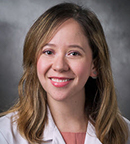Limited English-language proficiency may be a risk factor for receiving screening mammograms less often, according to new study results using national data. These findings, concerning women age 40 and older living in the United States, were presented at the American College of Surgeons Clinical Congress 2020, as well as published by Jose L. Cataneo, MD, and colleagues in the Journal of the American College of Surgeons.
“Spanish-only speakers appear to have a 27% less likelihood of having a screening mammogram than English speakers,” said lead study investigator Dr. Cataneo, a general surgery resident at the University of Illinois at Chicago/Metropolitan Group Hospitals.
“The impact of language barriers on screening mammography was previously unknown from a national database,” he continued. “It is important because approximately 67 million people in the United States speak a language other than English, and 41 million of those speak Spanish.” He cited recent U.S. Census Bureau estimates.

Jose L. Cataneo, MD

Celeste Cruz, MD
Mammograms have well-known benefits, added the study's senior investigator, Celeste Cruz, MD, a breast surgeon at Advocate Illinois Masonic Medical Center in Chicago.
“Mammography screening overall really reduces the rate of advanced and fatal breast cancers by finding cancers when they are at earlier stages and highly treatable,” she said.
Defining Limited English-Language Proficiency
The researchers defined limited English-language proficiency as speaking only or mostly a language besides English. For their study, they used a nationally representative database, the National Health Interview Survey, which is an annual survey of U.S. civilian, noninstitutionalized residents. Using the 2015 survey data, the research team included women between 40 and 75 years old—the age range usually recommended for screening mammography—who answered which language they primarily speak.
Among 9,653 women included in the study, 1,040 had limited English-language proficiency, according to the most recent study data reported at the Clinical Congress. Most of those women (n = 756) spoke only Spanish, said Dr. Cataneo.
Frequency of Screening Mammograms
In 936 limited English-language proficiency group members who provided mammogram information, the overall rate of screening mammograms was reportedly 12% less than for proficient English speakers: 78% vs 90%.
Women with limited English-language proficiency who reported never having received a screening mammogram numbered 209. When Dr. Cataneo extrapolated that number, using statistical software, to the entire U.S. female population in the age range of 40 to 75, he estimated it would equal 450,000 women in the country who are eligible for a screening mammogram but may not have had one.
Because U.S. mammography screening guidelines vary by age, the researchers examined participants in different age groups: 40 to 50, 45 to 75, and 50 to 75. “In all three groups, we found that those with limited English proficiency had less frequency of getting a screening mammogram,” he said.
To standardize the limited English-language proficiency and English-speaking groups, the researchers used a statistical method of matching them by age, race/ethnicity, insurance status, family income, and other factors. After this propensity score matching, speaking only Spanish predicted a significantly lower probability of getting a screening mammogram, with an odds ratio of 0.73, said Dr. Cataneo.
Determining Causes and Next Steps
Many reasons probably exist why low English proficiency is linked to reduced mammography screening rates, said Dr. Cruz. In their study, women with limited English-language proficiency were more likely than others to be poor and lack health insurance.
These women also may have fears surrounding mammography, she suggested. Dr. Cruz said health-care providers must dispel myths and focus on the importance of early detection of breast cancer.
Although breast cancer occurs in Hispanic patient at lower rates than in non-Hispanic White patients, it remains the leading cause of cancer-related death for Hispanic women, according to the American Cancer Society.
To address the language-based disparity in mammography screening rates, Dr. Cruz said her hospital is increasing educational efforts about breast health, the importance of screening, and advances in breast cancer treatment. Now being done virtually because of the coronavirus pandemic, this education includes seminars in Spanish for community members. Dr. Cruz also lectures through community organizations for health-care providers and employers that seek to promote breast health and screening.
Additionally, she said the hospital is working to make online mammography scheduling available in languages other than English.
Disclosure: For full disclosures of the study authors, visit journalacs.org.

